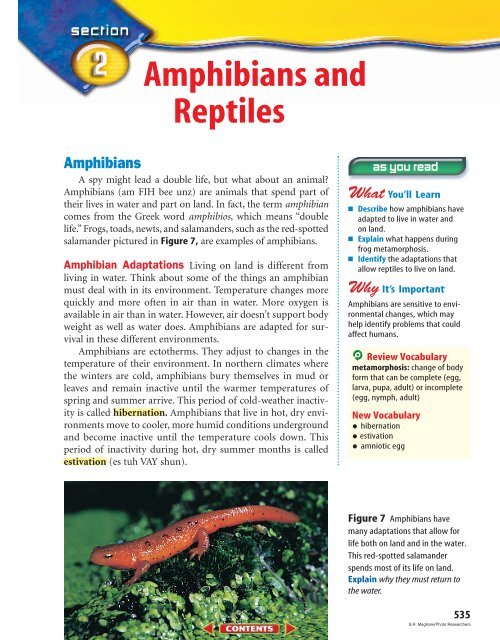Chapter 18: Vertebrate Animals
Chapter 18: Vertebrate Animals
Chapter 18: Vertebrate Animals
Create successful ePaper yourself
Turn your PDF publications into a flip-book with our unique Google optimized e-Paper software.
Amphibians and<br />
Reptiles<br />
Amphibians<br />
A spy might lead a double life, but what about an animal<br />
Amphibians (am FIH bee unz) are animals that spend part of<br />
their lives in water and part on land. In fact, the term amphibian<br />
comes from the Greek word amphibios, which means “double<br />
life.” Frogs, toads, newts, and salamanders, such as the red-spotted<br />
salamander pictured in Figure 7, are examples of amphibians.<br />
Amphibian Adaptations Living on land is different from<br />
living in water. Think about some of the things an amphibian<br />
must deal with in its environment. Temperature changes more<br />
quickly and more often in air than in water. More oxygen is<br />
available in air than in water. However, air doesn’t support body<br />
weight as well as water does. Amphibians are adapted for survival<br />
in these different environments.<br />
Amphibians are ectotherms. They adjust to changes in the<br />
temperature of their environment. In northern climates where<br />
the winters are cold, amphibians bury themselves in mud or<br />
leaves and remain inactive until the warmer temperatures of<br />
spring and summer arrive. This period of cold-weather inactivity<br />
is called hibernation. Amphibians that live in hot, dry environments<br />
move to cooler, more humid conditions underground<br />
and become inactive until the temperature cools down. This<br />
period of inactivity during hot, dry summer months is called<br />
estivation (es tuh VAY shun).<br />
■ Describe how amphibians have<br />
adapted to live in water and<br />
on land.<br />
■ Explain what happens during<br />
frog metamorphosis.<br />
■ Identify the adaptations that<br />
allow reptiles to live on land.<br />
Amphibians are sensitive to environmental<br />
changes, which may<br />
help identify problems that could<br />
affect humans.<br />
Review Vocabulary<br />
metamorphosis: change of body<br />
form that can be complete (egg,<br />
larva, pupa, adult) or incomplete<br />
(egg, nymph, adult)<br />
New Vocabulary<br />
hibernation<br />
• estivation<br />
amniotic egg<br />
Figure 7 Amphibians have<br />
many adaptations that allow for<br />
life both on land and in the water.<br />
This red-spotted salamander<br />
spends most of its life on land.<br />
Explain why they must return to<br />
the water.<br />
535<br />
S.R. Maglione/Photo Researchers

















